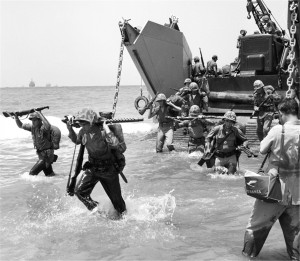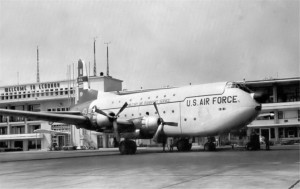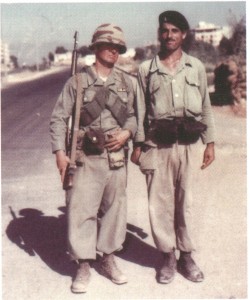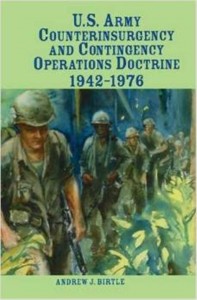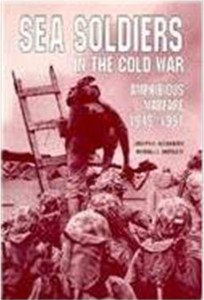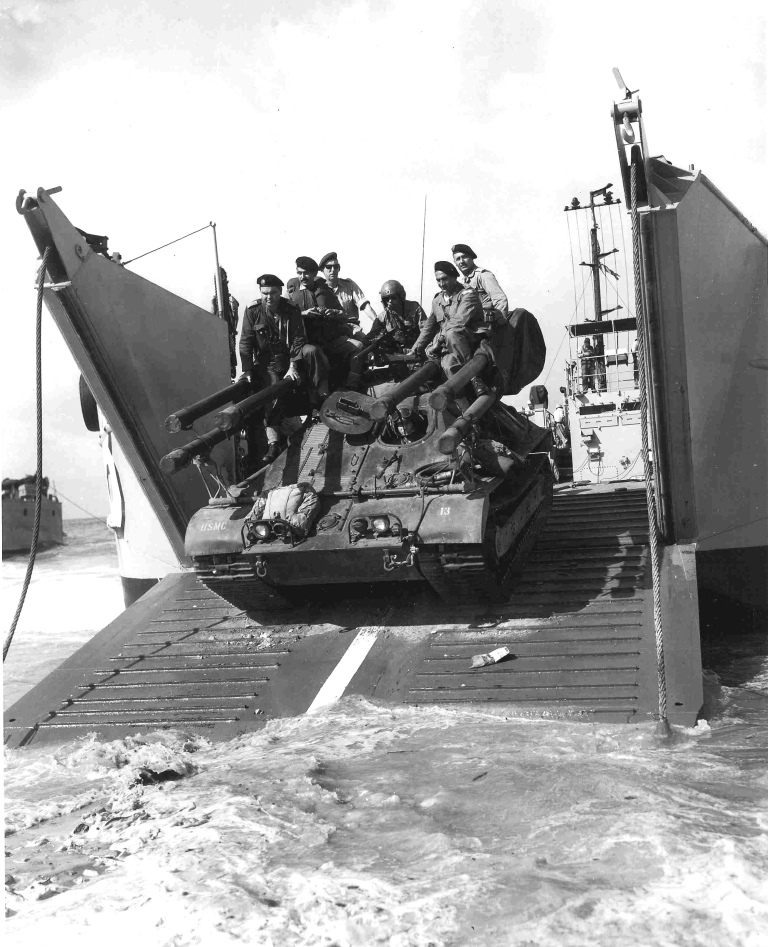 U.S. Marines and Lebanese Army personnel debark from the LCT (Landing Craft Tank) with one of the Marine Corps new ONTOS. Lebanese soldiers expressed keen interest in this manual vehicle with its six 106mm recoilless rifles mounted on their own self-propelled chassis. Lebanon 1958. USMC Photo
U.S. Marines and Lebanese Army personnel debark from the LCT (Landing Craft Tank) with one of the Marine Corps new ONTOS. Lebanese soldiers expressed keen interest in this manual vehicle with its six 106mm recoilless rifles mounted on their own self-propelled chassis. Lebanon 1958. USMC Photo The American had commandeered a Marine tank and a loudspeaker. Pulling up to the gate leading to the Moslem section of Beirut he had the tank’s 90mm gun pointed into the quarter. He announced through an interpreter that those who had taken the Marines hostage had three minutes to release them, their jeep… and their weapons… or he would open fire and turn the area into rubble… one building at a time.
The Marines, their jeep, and every last bullet was produced in less than three minutes. The American was not a Marine officer. Rather he was the United States Ambassador to Lebanon… When later asked by the Admiral if he really would have opened fire, he replied, “Of course…”
A classic amphibious operation that took place in peacetime was in Lebanon in 1958. The wisdom of getting involved might be questioned in hindsight, but at the time it appeared to be urgently required at the highest levels of the U.S. government… (Except for the Chairman of the Joint Chiefs who was afraid that “…we might be there for a decade or more…”)
Eisenhower was afraid that Arab Nationalism was a tool of the Soviets. (They supported it, but it was an independent movement.) In 1957 he declared that he would intervene if necessary in the Arab world to protect it from Communists and “nationalist extremists…” All declined except Lebanon.
Lebanon was a beautiful country that gave little sign on the surface of its problems. Beirut was the “Paris of the Middle East…” A mecca of beautiful women and excellent banks. Christians and Moslems (the latter at that time barely in the minority…) President would be Christian, PM Moslem, and so on. But Moslems were starting to question the census results.
The Lebanese (Christian) President (Chamoun) did not cut ties with the UK and France during the Suez invasion. More militant Moslems in Lebanon not happy about that. Then Egypt, Syria, and Yemen formed what was called The United Arab Republic… Moslem nationalists looking for a united Arab world got all excited (though the “union” wasn’t worth the paper that it was written on.)
More seriously, the Lebanese President was thinking about running for office again although the Constitution did not allow for that. One of his political enemies was assassinated by somebody and the temperature went up. Cracks began to appear and something like a low level civil war was starting.
Suddenly Iraq’s pro-West government was overthrown in July of 1958 by Arab nationalists. It seemed that Lebanon might be next. The Lebanese President asked Eisenhower for help. Khrushchev made an off the cuff remark about using nukes if the U.S. intervened… which convinced Eisenhower to act… thinking that maybe the Arab extremists were tools of the Kremlin. We were preparing to clutch the tar baby.
The American Ambassador in Lebanon was Robert McClintock. Kind of diplomat that is hard to find these days. From 1938-43 he had been the number three man at the U.S. Embassy in Finland. When Finland fought its second war with the Soviet Union in 1941 as a “co-belligerent” (not “ally”) with Germany… and German troops all over Finland… the U.S. left McClintock in charge of the Embassy. He flew the largest available American flag for the Germans to see.
McClintock was advised that American Marines would be coming ashore and was given a time… but not the landing area. He guessed (correctly) that it would be near Beirut’s airport.
He had a very good idea of what was really happening, but nobody in the administration or at the Pentagon thought to touch base with him. He thought that the landing was a bad idea.
When rioting and other disorders took place, the Commanding Officer of the Lebanese Army, General Faud Shihab declined an offer by some officers to stage a coup. He did not want the Army to split along religious lines. So he declared that the Army would remain neutral. Public buildings, utilities, the airport, etc. would be protected, but the Army would stay out of the fight.
McClintock feared that if Marines hit the beach, or paratroopers landed (or worse, were dropped) that the Lebanese Army would resist and everything would go to hell. His idea was to have a small number of tanks landed at the dock as a “show of support” but confine the intervention there.
He tried to radio the fleet, but nobody thought to have them prepared to hear from the ambassador. He scooped up General Shihab and they drove to the airport.
The General calmed his troops down and made sure that they did not block the runways… (if blocked, U.S. paratroopers would drop… and probably land all over hell and gone and any chance of an orderly approach would be shot…)
The Marines were in their landing craft and heading for the beach. Their commanders impressed upon them that barring the most urgent self-defense that they were not to fire without an order from an officer.
The Marines splashed ashore and were shocked to discover… a beach covered largely with very attractive women in bikinis…young boys selling them soda pop… and Western reporters and cameramen. One grizzled Marine commented, “It’s better than Korea… but I don’t know what the hell it is.”
The Marines headed for the airport. The battalion commander (2nd Battalion 2nd Marine Regiment, 2nd Marine Division) met up with the Ambassador and General Shihab. He contacted the (then) senior Navy officer by radio who said that while he appreciated the Ambassador’s point of view, the landing had been ordered by the Pentagon and the President and would continue until he might get a change of orders. He did agree to allow Lebanese Army guards a presence on the airfield.
The Marines had just finished securing the airport when the first transport aircraft arrived carrying paratroopers fully geared up for a combat jump.
The younger troopers were disappointed that they would not be making a combat jump. Their senior officers and NCO’s were grateful that their lads would not be scattered and maybe caught up in combat away from support. The Airborne had been flown in piecemeal… much better to have a peaceful administrative landing.
The Army took over at the airport, allowing the Marines to move onto other tasks. Army Brigadier General Gray overrode his staff’s recommendation that the troopers at the airport deploy in “pockets of company size” around the airport. Gray knew that his problem unlikely to be an assault by regular forces. If the airport became unusable his men could be guaranteed supplies by the fleet.
Meanwhile, the Marines had another battalion in the pipeline and more soldiers continued to arrive by air. Gray and his Marine counterpart, Marine Brigadier General Wade were about to send out patrols, and discovered that nobody had bothered to even talk to the Lebanese government about a “Status of Forces” arrangement. In theory their lads could be arrested by a Lebanese cop on the beat for dropping a gum wrapper in the street.
Also, in keeping with the “lash-up” nature of this operation, both generals were absolutely independent of each other. Both were rational officers who respected each other and might have been willing to have settled overall command (if not for their superiors in Washington) with a flip of a coin.
Instead the Navy flew a very senior admiral out to the fleet… and both generals had to report to him. He may have been a fine admiral, but he knew nothing of the problems of infantry in an explosive environment. Whenever possible the generals quietly worked things out between themselves.
The Army was trying to get a grip, but the Air Force started flying in a vast amount of supplies. A lot of it the Army did not need… Ultimately 50,000 tons. For an Army contingent that would ultimately number 8,509… it was a bit much.
Worse, the Army could not spare combat troops to guard the supplies… and “leg” soldiers were arriving… most in support roles. They were not keen on guarding the mountain of supplies and did a poor job of it. Lebanese thieves had a series of field days (or more properly, nights…)
American forces quickly took care of making sure that American citizens (and other Allied foreign nationals) were safe. But in spite of the trouble, they were in no immediate danger. In fact, in spite of dissident roadblocks, they could drive to and across the border into Israel.
Patrols of paratroopers and Marines sent out. More or less the “American” area would be 20K wide and 16K deep from the beach… though a few patrols went out as far as 32K. A few joint MP type jeep patrols moved through the streets.
One Marine jeep with a vehicle mounted machine gun was rushed on a narrow street by Moslem dissidents with submachine guns and whisked away into the Moslem quarter. The admiral had no clue how to handle this. The U.S. Ambassador got it handled in a “Direct Action Motivated” sort of way. (See opening paragraph…)
The Marines ultimately had 5670 men ashore (backed by 70 ships and 40,000 sailors…) When the soldiers outnumbered the Marines the Pentagon sent in an Army major general to take command on the ground… to the relief of the brigadiers and the Ambassador. He got along splendidly with all three.
General Shihab stationed Lebanese Army units between the Americans and the dissidents. Other than occasional sniper fire (one Marine killed… a few other Americans wounded) everybody learned to “just get along with each other…”
The Ambassador got through to Washington and they advised the Lebanese President that all Americans would vanish if he declared another (unconstitutional) run for the Presidency. He quickly issued a public statement that he would not run.
Two months later a new election resulted in General Shihab becoming the new President. His calm and evenhanded leadership had minimized the damage caused by the mini-civil war and his trust of the American Ambassador proved to be well placed. Both factions largely supported him. (He was a Christian…) Lebanon would not fall into the pit for the better part of a decade.
The Marines pulled out in September and the Army in October. Most Americans (unfortunately including most of those in the government) never understood that our lads had “danced between the raindrops” and just how close we came to “clutching the tar baby…”
Some wise generals, a splendid Ambassador… and a Lebanese general who proved himself to be both a patriot and a great man. In the early 1980s we would not be so lucky.
-YP-
http://www.amazon.com/Counterinsurgency-Contingency-Operations-Doctrine-1942-1976/dp/1782663460
http://www.amazon.com/Sea-Soldiers-Cold-War-Amphibious/dp/155750055X
Below is Aljazeera’s take on the 1958 Lebanon intervention. While biased, it is not rabid.
http://www.aljazeera.com/indepth/features/2013/07/201371411160525538.html
Below are several videos of various quality. The last one shows many different types of supply aircraft flying into Beirut airport. Eventually video switches over to film of soldiers arriving.
https://www.youtube.com/watch?v=jIb0vmUGcyM
https://www.youtube.com/watch?v=FwOTUzACmRQ
https://www.youtube.com/watch?v=HUfPu3SDmwY

